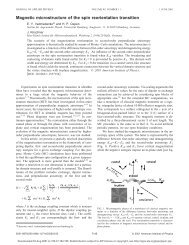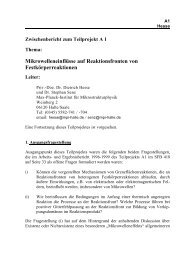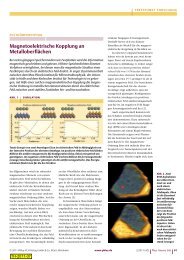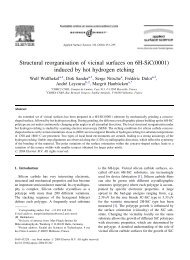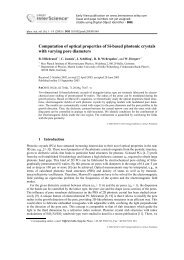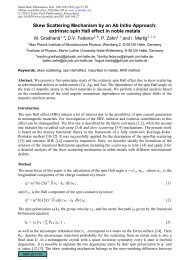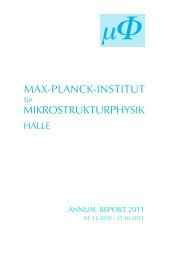Transition metals in photovoltaic-grade ingot-cast multicrystalline ...
Transition metals in photovoltaic-grade ingot-cast multicrystalline ...
Transition metals in photovoltaic-grade ingot-cast multicrystalline ...
You also want an ePaper? Increase the reach of your titles
YUMPU automatically turns print PDFs into web optimized ePapers that Google loves.
Fig. 4. Typical m-XRF po<strong>in</strong>t spectrum of the smaller Fe-rich particles <strong>in</strong><br />
Fig. 2. Iron, chromium and nickel are present <strong>in</strong> proportions suggestive of<br />
sta<strong>in</strong>less steel. The m-XAS spectrum for this particle appears <strong>in</strong> Fig. 3b.<br />
3.2. Metals <strong>in</strong> <strong>in</strong>got-<strong>cast</strong> mc-Si<br />
The spatial distributions and chemical states of metalrich<br />
particles <strong>in</strong> <strong>in</strong>got-<strong>cast</strong> mc-Si turned out to be very<br />
similar to those <strong>in</strong> the silicon nitride coat<strong>in</strong>g. In <strong>in</strong>got-<strong>cast</strong><br />
mc-Si, three types of impurity-rich particle are observed by<br />
our experimental techniques: (a) metal silicide nanoprecipitates,<br />
typically 30–60 nm <strong>in</strong> diameter, most often found<br />
along structural defects (especially gra<strong>in</strong> boundaries), (b)<br />
metal-rich <strong>in</strong>clusions, often measur<strong>in</strong>g up to a few tens of<br />
microns <strong>in</strong> diameter, and (c) extended microdefects (e.g.,<br />
silicon carbide or nitride) measur<strong>in</strong>g up to several tens or<br />
hundred of microns <strong>in</strong> diameter. Note that the experimental<br />
techniques used <strong>in</strong> this study are <strong>in</strong>sensitive to most<br />
metal po<strong>in</strong>t defects, such as <strong>in</strong>dividual <strong>in</strong>terstitial or<br />
substitutional metal atoms.<br />
The metal silicide nanoprecipitates detected <strong>in</strong> <strong>in</strong>got-<strong>cast</strong><br />
mc-Si are usually found at structural defects (e.g., gra<strong>in</strong><br />
boundaries) and typically conta<strong>in</strong> Ni, Fe, Cu and/or Co,<br />
<strong>in</strong>cidentally the 3d transition metal species with highest<br />
solubilities and diffusivities <strong>in</strong> silicon. Further details on<br />
structure and properties of metal particles <strong>in</strong> silicon can be<br />
found <strong>in</strong> our recent publications [4,5,19]. A much higher<br />
concentration of these precipitates is observed towards the<br />
bottom, top and edges of the <strong>in</strong>got. The total amount of<br />
<strong>metals</strong> conta<strong>in</strong>ed <strong>in</strong> these precipitates is estimated by m-<br />
XRF to reach values as high as 3 10 14 cm 3 [5] or higher.<br />
On the other hand, <strong>in</strong> the middle of the <strong>in</strong>got, such<br />
precipitates are rarely observed above the current m-XRF<br />
detection limits.<br />
Micron-sized particles <strong>in</strong> mc-Si are often composed of<br />
oxidized Fe or Ti (an example of such particle is shown <strong>in</strong><br />
Ref. [5]). In addition, particles conta<strong>in</strong><strong>in</strong>g Ca, Zn, Mn, Mo<br />
and/or Cr, with traces of fast diffusers were also observed.<br />
The abundance of slowly diffus<strong>in</strong>g elements, comb<strong>in</strong>ed<br />
with their frequently oxidized chemical state lead us to<br />
conclude that these particles are <strong>in</strong>clusions and not<br />
precipitates [4,5]. The spatial density of these particles is<br />
orders of magnitude lower than metal silicide nanoprecipitates.<br />
However, each <strong>in</strong>clusion particle conta<strong>in</strong>s a far<br />
ARTICLE IN PRESS<br />
T. Buonassisi et al. / Journal of Crystal Growth 287 (2006) 402–407 405<br />
Fig. 5. (a) IRTM image of a b-Si3N4 rod encircled by SiC clusters, found<br />
<strong>in</strong> the upper part of a <strong>cast</strong> mc-Si <strong>in</strong>got; (b–d) m-XRF maps of the same<br />
region. Homogeneously distributed Ca and FeSi 2 are present at the<br />
b-Si3N4 rod. Particles of FeSi2 and Cu3Si are also present at the SiC<br />
clusters. All of these impurities are also present <strong>in</strong> a-Si3N4 powder <strong>in</strong> high<br />
concentrations (Figs. 1 and 2).<br />
greater number of metal atoms than a metal silicide<br />
nanopreciptiate. Consequently, these particles were found<br />
to account for local metal contents as high as<br />
2.3 10 16 cm 3 [5] <strong>in</strong> regions of the <strong>in</strong>got where they are<br />
most prevalent (top, bottom and edges).<br />
Metals are also found at Si 3N 4 and SiC microdefects<br />
towards the top of the <strong>in</strong>got. These microdefects are<br />
specific for <strong>in</strong>got-<strong>cast</strong> mc-Si; the significance of f<strong>in</strong>d<strong>in</strong>g<br />
these microdefects is discussed below. An IRTM image<br />
(Fig. 5a) of one collection of microdefects reveals a b-Si3N4<br />
rod surrounded by several b-SiC clusters. FeSi2 and Ca<br />
(chemical state not determ<strong>in</strong>ed) are found rather homogeneously<br />
distributed with<strong>in</strong> the b-Si3N4 rod (Figs. 5b,d),<br />
while FeSi 2 and Cu 3Si particles are observed with<strong>in</strong> the SiC<br />
clusters surround<strong>in</strong>g the Si 3N 4 rods (Figs. 5(c) and (d)).<br />
4. Discussion and conclusions<br />
The results presented <strong>in</strong> this study strongly <strong>in</strong>dicate that<br />
the silicon nitride coat<strong>in</strong>g could contam<strong>in</strong>ate <strong>cast</strong> mc-Si<br />
<strong>in</strong>gots with an assortment of metallic and non-metallic<br />
impurities dur<strong>in</strong>g crystal growth. Firstly, the relative<br />
concentrations of elemental impurity species <strong>in</strong> a-Si 3N 4 are<br />
similar to those impurities found <strong>in</strong> <strong>in</strong>got-<strong>cast</strong> mc-Si, as<br />
shown <strong>in</strong> Fig. 1. It must be noted that the bulk impurity<br />
concentrations <strong>in</strong> the nitride coat<strong>in</strong>g and <strong>in</strong>got-<strong>cast</strong> mc-Si<br />
wafers were measured us<strong>in</strong>g different experimental techniques,<br />
each sensitive to a different set of elements (e.g.,<br />
NAA is not well-suited to detect low-Z elements such as<br />
carbon and nitrogen, but it has better sensitivity than ICP-<br />
OES to some transition <strong>metals</strong>). Secondly, the chemical<br />
states of certa<strong>in</strong> impurity-rich particles <strong>in</strong> a-Si 3N 4 and<br />
<strong>in</strong>clusions <strong>in</strong> <strong>in</strong>got-<strong>cast</strong> mc-Si are practically identical,<br />
as shown <strong>in</strong> the overlapp<strong>in</strong>g m-XAS spectra <strong>in</strong> Fig. 3a.<br />
Thirdly, the distribution of impurities <strong>in</strong> <strong>in</strong>got-<strong>cast</strong> mc-Si



